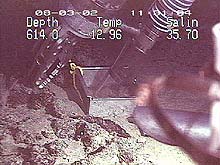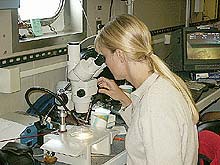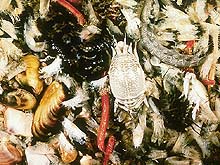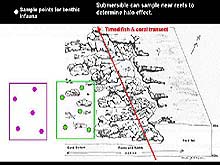
An attachment on the Johnson Sea Link can be used to “vacuum” an area of the seafloor. The sample size is limited to a known area using a small metal frame. Click image for larger view.
Sampling Techniques—Infaunal Organisms
August 03, 2002
Pam Jutte, Marine Scientist
South Carolina Department of Natural Resources
![]() Watch a video of two different sampling techniques used by the submersible. (mp4, 2.7 MB)
Watch a video of two different sampling techniques used by the submersible. (mp4, 2.7 MB)
Last night, everyone aboard the R/V Seward Johnson paid close attention to threatening weather patterns along the eastern seaboard. Fortunately both morning and afternoon dive operations proceeded as scheduled. The submersible crew hoisted the Johnson Sea Link II (JSLII) aboard for the second time today at 7:55 pm. Dives #3297 and #3298 targeted the Charleston Lumps South, by far the deepest areas we have explored so far on Leg 1. In comparison to the previous six days of video, today’s footage from 700 ft. shows a vastly different benthic environment. Everyone in the science team spent the day ‘oohing and ahhhhing’ over the samples the JSL II brought up from the bottom.
Context is Everything!
The grab scoop is a tool used by the JSL to literally take a ‘bite’ of the ocean floor. This tool uses the same concept as the Young grab that we are using from the surface. We are also using a suction sampler, which uses a vacuum cleaner-like attachment to collect sandy samples from the top of hard or rocky bottom. The great advantage of taking samples while actually on the seafloor is that you know exactly where the sample is collected. With typical surface-based grab samples, while you may know the exact latitude and longitude where your samples are collected, and you can get an idea of what that tiny area of the bottom is like from the sample you collected, you know very little about what the area nearby your sample was like. This may seem like a minor detail, but the habitat surrounding a sandy patch, or the distance to the nearest reef feature, can result in dramatic changes in the number and type of organisms that live there. Therefore, knowing exactly where our samples are collected in these deep habitats allows us to learn even more from every sample we collect.

Two techniques were used on the Johnson Sea Link to collect benthic samples: the grab scoop and the suction sampler. Click image for larger view.
The important role of the infauna is most apparent around rocky outcrops or reef structures found in the open ocean. Many varieties of fish congregate around deep-water reefs, and the infauna can be an important source of food. Certain types of fish, especially juveniles, will leave the shelter of the rocky outcrops and go foraging out over the open sand, feeding upon the animals that they find.
The technical term for the invertebrate organisms we are collecting in the grab scoops and suction samples is benthic macrofauna. These are defined as organisms that live on the seafloor and have a total length greater than 0.5 mm, and less than about 1 cm. Specifically, we are interested in the organisms living beneath the sediment surface (infauna), rather than those living on top of the sediment surface (epifauna). Benthic invertebrates include animals such as polychaete worms, amphipod crustaceans, bivalve mollusks, and snails. Biologists called taxonomists have special training in recognizing the characteristic features of these tiny animals, and are tasked with identifying and counting the benthic macrofauna collected.
When benthic macrofauna are examined under a microscope, they really are an amazingly diverse group of animals. Some polychaete worm species have large jaws and are ferocious predators in their small worlds. Others worms are coated with glistening scales that resemble golden armor. Amphipod crustaceans are shrimp-like animals with seven pairs of legs. There are more than 5,500 species of amphipods worldwide, and most species are marine. The bivalves and gastropods, commonly known as clams and snails, show a complex variety of shell patterns, colors and sizes.

Typical benthic invertebrates include marine worms, tiny crustaceans, clams, and snails. Click image for larger view.
We are interested in the different benthic invertebrates found in each sample for a variety of reasons. Due to their close contact with the ocean floor sediments and their limited mobility, benthic invertebrates can provide insight on the effects of environmental change, including changes in sediment composition or contaminant levels. These animals also provide a food source for many fish and motile crustaceans, and patterns in the abundance and distribution of the benthic invertebrates can tell us more about how fish may be foraging in the area or the utility of the area as fish foraging grounds.
Our Sampling Strategy
The benthic macrofaunal sampling strategy was planned to address three general questions. First, are there differences in the community structure found close to the reef versus further away? Second, are there differences in the number and type of benthic invertebrates that live in the sandy veneer on top of reefs when compared to the sandy areas surrounding reef habitats? And third, what benthic macrofauna abundance and diversity are found among different reef sites in the South Atlantic Bight? To answer these questions, we are collecting multiple samples at each dive site. In an area near the reef (5 to 25 m away), we will collect five samples, and an additional five samples will be collected further away from the reef (30 to 50 m away). In each of these two areas, the multiple samples will serve as replicates. The collection of replicate samples is a way to get a more statistically sound description of the benthic invertebrates found in each area. Instead of collecting one sample and hoping that it has a representative array of species and a typical abundance of organisms, we can look at the variability among the five samples collected at each habitat type and get a more accurate description of each area.

This diagram of a typical deep reef habitat shows the direction of video surveys (red arrow), and the location of benthic samples collected near the reef (green dots) and further from the reef (purple dots). Click image for larger view.
However, as with most things, there are trade-offs. The submersible has space limitations on the number of samples we can collect on each dive, and the more replicates we collect at a single site, the fewer sites we can sample on a dive. Each grab scoop sample is dumped into a large plexiglass container on a rotating conveyor belt. After we sample at the two areas, we fill 10 of the 12 sample containers. We will fill the two remaining sample containers with suction samples from the sandy veneer overlying the reef. Or, if unusual sediments are observed adjacent to the reef, we will collect additional grab scoop samples. While our sample size will be limited at these “extra” habitats, we will at least have a baseline description of the typical organisms present.
Sign up for the Ocean Explorer E-mail Update List.














































